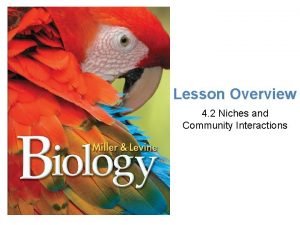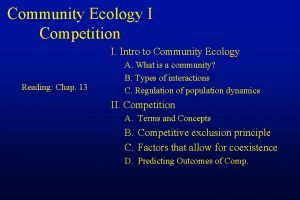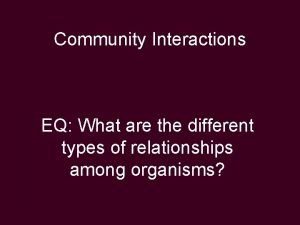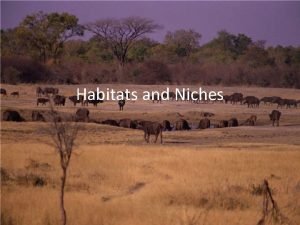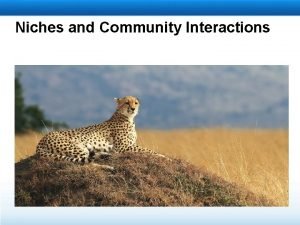Niches and Community Interactions What is a Niche








- Slides: 8

Niches and Community Interactions

What is a Niche? - Habitat: the general place where an organism lives - Niche: a range of biotic and abiotic conditions in which species live, and the way the species obtains what is needs to survive and reproduce - Resources: necessities of life - Plants: sunlight, water, nutrients - Animals: nesting, space, shelter, food - Physical (abiotic): environment, weather, natural disasters - Biological (biotic): how it eats, how it reproduces, how it interacts with other species

Tolerance - Tolerance: the ability to survive and reproduce under a range of environmental circumstances - Organisms have an upper and lower limit of tolerance for every environmental factor - Once they reach their optimum range, the organism experiences stress - Beyond their tolerance level, the organism will not survive

Tolerance Graph

Competition - Competition can occur between similar species (intraspecific competition) and between member of different species (interspecific competition) - Competitive Exclusion Principle: no 2 species can occupy the same niche in the same habitat and exactly the same time - Instead species will divide resources

Predation/Herbivory/Keystone Species - Predator-Prey Relationships: predators can affect the size of the prey population and determine where the prey can live and feed - Herbivory-Plant Relationships: herbivores can affect both size and distribution of plants and where the plants can grow and survive - Keystone species: a newly introduced species affects the population of another species - algae→ sea urchin→ sea otter

Symbiotic Relationships - Symbiosis: any relationship between two species that live closely together - Three types of symbiosis: - Mutualism: a relationship between two species in which both benefit - Parasitism: a relationship between two species in which one lives on or in the other organism with intentions to harm it (they do not kill the host) - Example: Clownfish and Anemone Example: Tapeworms/Lice/Leeches Commensalism: a relationship between two organisms where one organism is help and the other is neither helped nor harmed - Example: Barnacles and Whales

Examples of Symbiotic Relationships Mutualism Parasitism Commensalism

